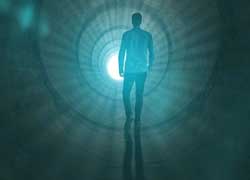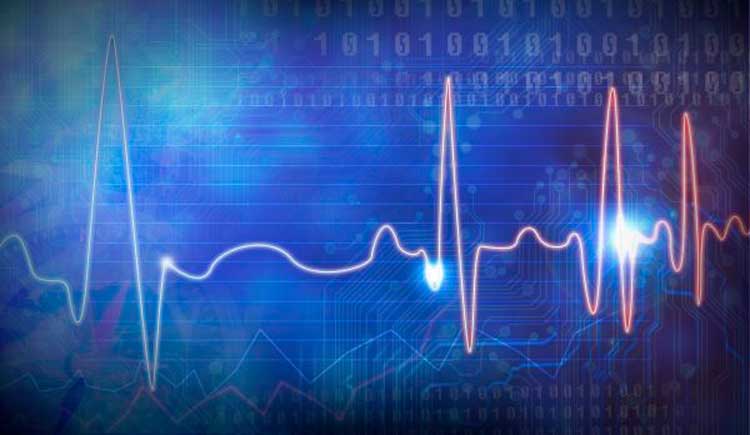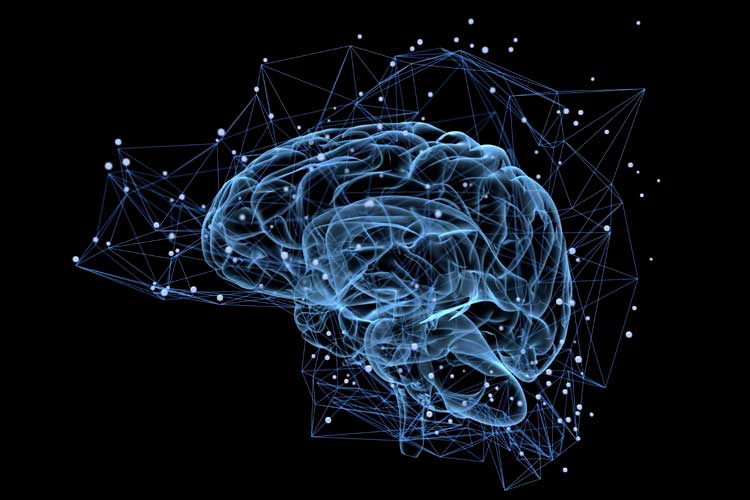Does Life Flash Before the Eyes Upon Dying?
 Study: Specific Patterns of Waves Recorded in a Dying
Study: Specific Patterns of Waves Recorded in a Dying
Death has always been a mystery to human beings. What can people see or feel when they are dying? Scientists who recorded the brain waves of a dying patient may have insights into the mystery.
When using continuous electroencephalography (EEG) to record the brain waves of an 87-year-old epileptic man, an international team of scientists monitored his brain activity as he suffered a heart attack and died. The study was published in the February 2022 issue of Front Aging Neuroscience.
Brain Waves Highly Active After Cardiac Arrest
Dr. Ajmal Zemmar, a neurosurgeon at the University of Louisville who took part in the study, said specific patterns of brain waves appeared in the patient’s brain 30 seconds before and after his heart stopped beating.
“Through generating oscillations involved in memory retrieval, the brain may be playing a last recall of important life events just before we die, similar to the ones reported in near-death experiences,” Zemmar told Frontiers.
A 2013 study published in the National Academy of Sciences found that all nine mice in the experiment had highly active brain waves for 30 seconds after cardiac arrest. This is strikingly similar to what Zemmar’s team found in their patient near death.

EEG reveals different patterns of brain activity
Near-Death Experiencers Look Back on Their Lives
The phenomenon of “looking back on life” just before or while dying has happened to many near-death experiencers.
Dannion Brinkley, author of Saved by the Light, wrote about his two near-death experiences. After its publication in 1994, the book was listed as a best-seller by The New York Times for five consecutive months.
Brinkley recalled to readers his first near-death experience on Sept. 17, 1975. During a storm that hit Aiken, South Carolina, the 25-year-old Brinkley was at home, talking on the phone with a friend, when a bolt of lightning struck him through the telephone line, throwing him into the air.
After experiencing immense heat and pain, Brinkley says he felt his soul leave his body and that he felt bathed in peace and tranquillity. He said he floated in the air watching his family and friends panic and give him first aid. He saw ambulances rush in and take his body to the hospital. Brinkley’s soul went through a tunnel into a place of light.

Brinkley then began to look back on the 25 years of his life, seeing even the tiniest details. He was surprised to find that he could relate to the feelings of other people affected by incidents he was involved in. Brinkley grew up unrestrained and was a bully who took pleasure in fighting and humiliating others. In reviewing his history, he felt firsthand the pain, fear, panic, and helplessness felt by his victims.
In one such memory, Brinkley shot and killed a North Vietnamese officer during the Vietnam War. In his near-death experience, Brinkley felt the confusion that the officer felt when he was shot in the head, as well as the helplessness and sorrow that he could not see his family again. What’s more, he felt the pain the officer’s family felt for years after they learned of his death. When the flashback finished, he was overwhelmed with remorse and shame. After returning to the mortal world, Brinkley changed himself completely and did everything he could to help others.
Near-Death Experiences Not Uncommon
The term “near-death experience” was coined by Dr. Raymond Moody, a renowned psychologist, and professor at the University of Nevada. In 1975 Moody published “Life After Life,” a book based on his study of 100 patients who had experienced “clinical death” and came back to life. He shared their experiences about the world after death in their own words. Since then, much more scientific research has been conducted on near-death experiences.
In a 2014 study published in Frontiers in Human Neuroscience, researchers studied 190 near-death experiences with different characteristics, including those that occurred after non-life-threatening events such as sleep, meditation, and fainting—as well as near-death experiences that occurred during coma caused by lack of oxygen, trauma, or disease.
Several similarities were found in the near-death experiences, including seeing bright lights, the sensation of being outside of one’s body, and flashes of past events. The most frequent near-death experience, reported by 89 to 93 percent of participants in each category was “a feeling of peace or pleasantness.”
A fact that may be surprising to some is that many people have near-death experiences. A study published in Psychiatry in 1993 estimated that about five percent of the adult U.S. population has had a near-death experience—that’s 30 to 40 percent of individuals who come close to death. A 2001 Dutch study published in The Lancet found that of 344 patients who were successfully resuscitated after a cardiac arrest, 62 (18 percent) reported having a near-death experience.
Hong Kong Writer Shares Miraculous Near-Death Experience
Chip Tsao, a Hong Kong writer, recounted his 1994 miraculous near-death experience in an interview on the YouTube channel of Stephen Chan Chi-wan, the chief advisor of Commercial Radio Hong Kong.
Tsao recalled that in 1994 when he was 36, he was taken to a hospital dying after a serious car accident. After 15 hours of emergency surgery, the doctor told him that all medical options had been exhausted and “now it’s up to your willpower.” As he lay dying, Tsao saw a large sea in front of him, with golden and pink lotus flowers as big as round tables floating in the sea. He also heard sutras being chanted in his ear.

Hong Kong writer Chip Tsao told about his miraculous near-death experience
Tsao said the experience was very clear and real as if there was a force pushing him over, but there was also a voice inside him telling him not to cross over because he had so many unfinished undertakings.
“It was a feeling of fear, but also peace,” he said. “I kept asking myself. It would be comfortable to cross over. Those lotus flowers would take me to another place like a boat.”
The famous writer also experienced several things that even science couldn’t explain.
As he lay in the ICU, Tsao could hear his parents discussing his treatment and whether to hire a second chest doctor to join the team. He also heard his parents crying. Half a month later, Tsao was moved from ICU to a general ward. When his parents came to visit him, he told them that while he was unconscious, he heard them discussing hiring a specialist.
His father said it was true but was surprised because they had discussed it in a hotel room away from the hospital.
“How could you possibly hear it, so far away?” The father asked.
Yet Tsao was assured that he was not hallucinating since he heard the conversation clearly and could even repeat it.
Another miraculous event was that when Tsao was in ICU, his friends came to visit him. The next day, Tao saw these friends visit him again, wearing the same clothes and speaking the same words. Tao felt very strange. After inquiring, he learned that he foresaw his friends visiting him the next day in his near-death experience.
These experiences gave Tsao a deeper understanding of the meaning of life and death.
“Having seen things in the future and left this space, there should be another place for people after death,” he said. Later in his life, Tsao had two more brushes with death, which gave him a new view on life, space-time, and afterlives. His experience also made him believe that there is a higher force above mankind.
Study: Mental Clarity During Near-Death Experiences Suggests Mind Exists Apart From Brain
If the mind is just a function of the brain, it stands to reason that the worse the brain is injured, the worse the mind would function. While this is what much of current brain research is finding, a body of evidence exists suggesting otherwise: under extreme circumstances, such as close to death, the mind may function well—or even better than usual—when the brain is impaired.

This suggests the mind may function independently of the brain.
One of the researchers who has been studying such cases is Dr. Alexander Batthyany, a professor of theoretical psychology and the philosophy of psychology in Liechtenstein and at the cognitive science department at the University of Vienna.
In his most recent study, published this month in the Journal of Near-Death Studies, Batthyany and his colleagues reviewed thousands of accounts of near-death experiences (NDEs) to determine the quality of vision and cognition.
He reported: “The more severe the physiological crisis, the more likely NDEers are to report having experienced clear and complex cognitive and sensory functioning.”
Part of Batthyany’s goal was to replicate earlier studies, few as they are, that have looked at the quality of vision and cognition during NDEs.
In a 2007 study by researchers at the University of Virginia, titled “Unusual Experiences: Near Death and Related Phenomena,” 52.2 percent of NDEers reported clearer vision. Jeffrey Long, M.D., founder of the Near Death Experiences Research Foundation (NDERF), found in a survey of 1,122 NDEers, that about 74 percent reported “more consciousness and alertness.”
“I felt extremely aware, totally present, sharp, and focused. In hindsight, it’s like being half asleep when I was alive, and totally awake after I was pronounced dead,” said one experiencer, as noted in Batthyany’s study.
“It’s like being half asleep when I was alive, and totally awake after I was pronounced dead”. — NDEer
“My mind felt cleared and my thoughts seemed quick and decisive. I felt a great sense of freedom and was quite content to be rid of my body. I felt a connection with everything around me in a way that I cannot describe. I felt as if I was thinking faster or that time had slowed down considerably,” said another.
While Batthyany’s study confirmed, to a certain extent, the results of the previous studies that had shown an increase in cognitive and sensory functioning during NDEs, his methodology had some limitations. He said these limitations may have led to lower estimates for the percentage of NDEers who have heightened cognition.
Methodology Limitations
He compiled thousands of written accounts from online repositories of experiences, such as the NDERF website, and ran them through a computer program, which identified words related to vision or cognition (such as “saw” or “thought”).
He and his colleagues then rated the quality of vision or cognition described in this smaller sample on a scale from -2 to +2. They further narrowed their study to experiences that included detailed explanations of the medical conditions that accompanied the NDEs. Only patients with cardiac and/or respiratory arrest were included in this study.
Previous studies had asked NDEers directly about the quality of their vision and cognition. Batthyany’s study, however, could only analyze the information given in general NDE accounts. So, for example, when he decided that there was “no change” in cognition or vision in some accounts, it may have been that there was indeed a change but that the NDEer hadn’t described it specifically enough to be counted.
Of the NDEers who mentioned visual perception, about 47 percent said they had enhanced vision. And 41 percent had unchanged vision, “which in itself is quite remarkable, given that these patients were in a severe medical crisis, and often unconscious,” Batthyany said in an email to Epoch Times.
Of the NDEers who made explicit references to awareness and mentation, about 35 percent said they had increased awareness and mentation. And about 61 percent reported normal everyday awareness during cardiac and respiratory arrest.
Given the implications of his study, Batthyany was careful to note other shortcomings in his methodology, including the fact that online NDE descriptions may include some fraudulent reports. But, he also noted reasons that these methodological shortcomings do not likely impact his overall finding that NDEs, by and large, include improved vision and cognition.
For example, concerning the risk of including fraudulent accounts, he wrote: “On NDERF, the largest contributor of NDEs studied here, less than 1 percent of posted NDEs have been removed due to concerns about their validity. Additionally, given the sheer number of accounts, it is unlikely that fake reports have significantly biased our results in one or the other direction. One would expect fake accounts … to be prototypical of the popular NDE narrative.”
Patients who have been completely incoherent for many years seem to suddenly return to their senses shortly before death.
In addition to these NDE studies, studies on the phenomena of terminal lucidity and mindsight also support the conclusion that the mind may engage in complex conscious activity even as brain functioning severely deteriorates, Batthyany said.
Terminal Lucidity, Mindsight
He has studied terminal lucidity in Alzheimer’s patients. This is a phenomenon in which patients who have been completely incoherent for many years seem to suddenly return to their senses shortly before death.
When the brain is at the furthest stage of degeneration, the expectation would be that the ability to make coherent connections between memories and various thoughts and emotions would be so far gone that a “whole” person could no longer emerge. Yet at this time, the whole mind seems to flash through, with all its connections intact.
“Mindsight” refers to the phenomenon in which blind people report being able to see during NDEs. This has been studied, for example, by Kenneth Ring at the University of Connecticut. Ring found that 15 out of 21 blind participants reported some kind of sight during NDEs.
Hallucinations?
Batthyany noted that some scientists consider NDEs to be hallucinations produced by neurophysiological processes.
“The findings reported in this paper and cases of terminal lucidity and mindsight, however, appear to suggest otherwise in that they indicate the presence of complex and structured conscious experience during decline, breakdown, or absence of the neurobiological correlates commonly held to be causative factors of NDEs—and of conscious experience in general,” he said.
He concluded that consciousness—including a sense of selfhood, complex visual imagery, and mental clarity—can sometimes outlive altered brain functioning, including even a flatline of electrical activity in the brain.
Terminal lucidity and mindsight are very rare phenomena, but NDEs are more numerous and “our results suggest that the continuity of visual imagery, mentation, and sense of selfhood is the rule rather than the exception during NDEs.”
Batthyany wrote: “It remains for future researchers to confirm or disconfirm our informal observation through formal analysis.”
His study, “Complex Visual Imagery and Cognition During Near-Death Experiences,” can be found in Volume 34, No. 2, of the Journal of Near-Death Studies.



